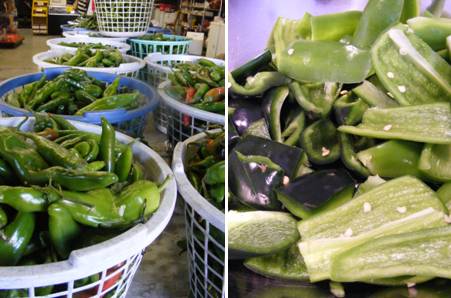Sweet Potato: Jamaican Sweet Potato Curry
Wednesday, December 9th, 2009What kind of sweet potato person are you? A. Eat sweet potatoes at Thanksgiving meal and don’t eat them otherwise; B. Eat sweet potatoes year round; C. Don’t eat sweet potatoes. I predict most folks fall into the holiday eater group and these lovely tubers get ignored the rest of the year. What a shame because they are nutritionally loaded with Vitamins A and C. And, the better part (for some), they taste great even under the simplest of cooking methods (boiled or baked) and without added fats and spices.
Here, however, we’re using the spice rack . . . Jamaican style! Sweet potatoes are simmered in a warm spice mixture common to Carribbean cuisine: ginger, cardamom, cinnamon, cumin, cloves and allspice. Then, it’s made luscious with coconut milk. For an added touch of Caribbean influence, I’ve added okra and I served it all on a bed of sautéed kale, since it was easier to locate in my neighborhood than the Jamaican spinach callaloo.
This is a vegetarian curry that can be enjoyed as a main or a side. It’s nutritious comfort food when the weather outside is frightful. It is hearty akin to the consistency of a thick butternut squash soup. And, the taste is deep – the Indian influence is certain. Each spoonful makes me close my eyes and long to transported to an island far away.
The recipe is adapted from the Jamaican Fish Curry recipe in one of my favorite cookbooks, The Caribbean: Central & South American Cookbook by Jenni Fleetwood and Marina Filippelli (2007). It’s definitely a go to book for Caribbean cooking with make-you-want-to-cook recipes, beautiful photography and easy instructions.
Enjoy! With this dish I bet some C. types would convert.
Tidbits on Sweet Potatoes
- The origin of sweet potatoes is believed to be located in Central America with its ancestral roots in the Mexican wild yam. They have been cultivated for more than 5,000 years, although fossilized remains in the Andes date back 8,000 years.
- Sweet potatoes were the second most important root crop in the United States at the beginning of the twentieth century. In 1920, per capita consumption was 31 pounds. In 1999, consumption dropped to a mere 4 pounds per person.
- China grows about 87 percent of sweet potatoes grown worldwide; with nearly half used as feed for animals. Asia produces 6 percent, Africa 5 percent, Latin America 1.5 percent, and the United States 0.45 percent.
- Sweet potato flesh comes in a spectrum of colors: white, yellow, purple, red, pink, violet and orange. Nutritionally, all varieties are good sources of Vitamins C and E as well as dietary fiber, potassium, and iron, and they are low in fat and cholesterol. The orange and red fleshed sweet potatoes are an excellent source of beta-carotene (Vitamin A).
Source: Encyclopedia of Food and Culture.






